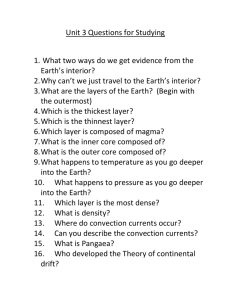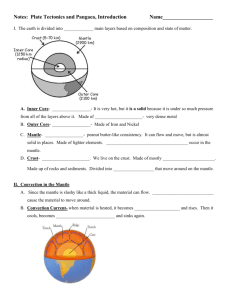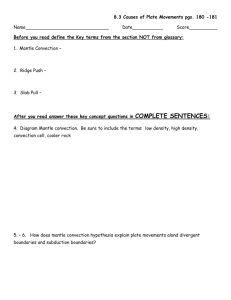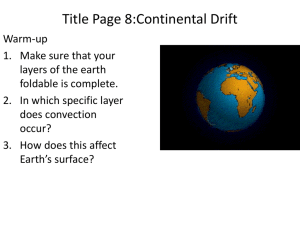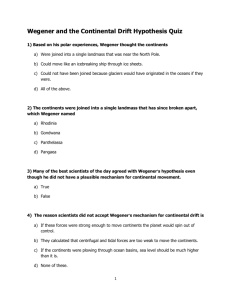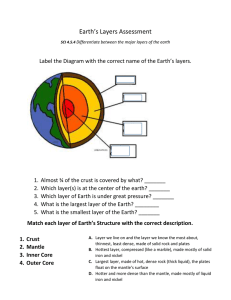solid rock
advertisement
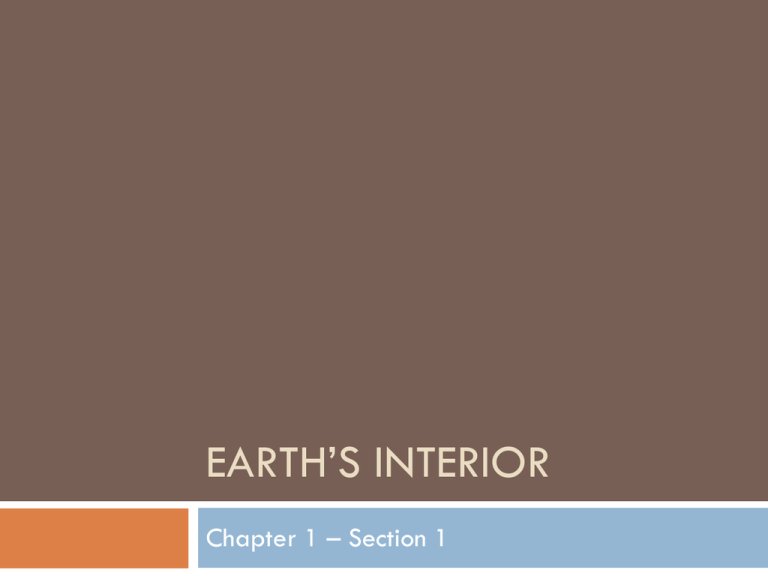
EARTH’S INTERIOR Chapter 1 – Section 1 A. Exploring inside the Earth Direct evidence 1. a. Rock samples Indirect evidence 2. a. Seismic waves B. Journey to the Center of Earth Temperature 1. Increases with depth (after 20 meters) Results from- a. b. a. b. formation of the earth decay of radioactive materials Pressure 2. a. b. Increases with depth Results from weight of rocks above C. The Crust The skin of the earth Oceanic 1. 2. a. b. c. Thin Dense Rock - basalt Continental 3. a. b. c. Thick Less dense Rock - granite D. Mantle Layer of hot solid rock Lithosphere 1. 2. a. Upper mantle and crust Asthenosphere 3. a. b. Softer part of mantle Bends/flows like plastic Lower Mantle 4. a. b. Solid Extends to core E. The Core Made of iron and nickel Outer Core 1. 2. a. b. Molten (liquid) metal Cause of Earth’s magnetic field Inner Core 3. a. Solid metal Answer in your Notebook Questions 1-3 on page 13 AND Questions 1-4 on page 12 Use complete sentences when answering the questions. Be sure to indicate what page number your questions are from in your notebook. Convection and the Mantle Chapter 1 – Section 2 A. Types of Heat Transfer Radiation 1. a. b. c. Transfer of energy through space No direct contact Sunlight , fire Conduction 2. a. b. Heat transfer within a material or between materials Some of the heat transfer within the earth Convection 3. Heat transfer by the movement of fluids Caused by the differences of temperature and density of a fluid a. b. Hotter = particles farther apart = less dense Colder = particles closer together = more dense B. Convection Currents 1. Flow that transfers heat within a fluid C. Convection Currents in Earth 1. 2. Heat from core and mantle cause convection currents within the mantle Very Slowly within the solid mantle Mantle simulation Answer in your Notebook Questions 1-3 on page 17 Use complete sentences for all questions! Be sure to indicate what page number your questions are from in your notebook. Drifting Continents Chapter 1 – Section 3 A. Continental Drift Alfred Wegener – 1910 1. Studied land features, fossils, and evidence of climate change Continental drift - all continents were once together in a single landmass and have since drifted apart Pangaea – “all lands” a. b. c. i. 300 million years ago B. Evidence for Continental Drift Land Features 1. Mountain ranges Coal fields a. b. Fossils 2. Similar organisms found on continents separated by oceans a. i. ii. Glossopteris – Fernlike plant Mesosaurus and Lystrosaurus – freshwater reptile Climate 3. Fossils of organisms from warmer climates support movement of continents a. i. ii. b. Equator = warm climate Poles = colder climate Evidence of glaciers indicate colder climate C. Wegener’s Hypothesis Rejected 1. 2. Idea rejected because he could not identify the cause of continental drift Continued his work and died in 1930 exploring Greenland’s glacier
